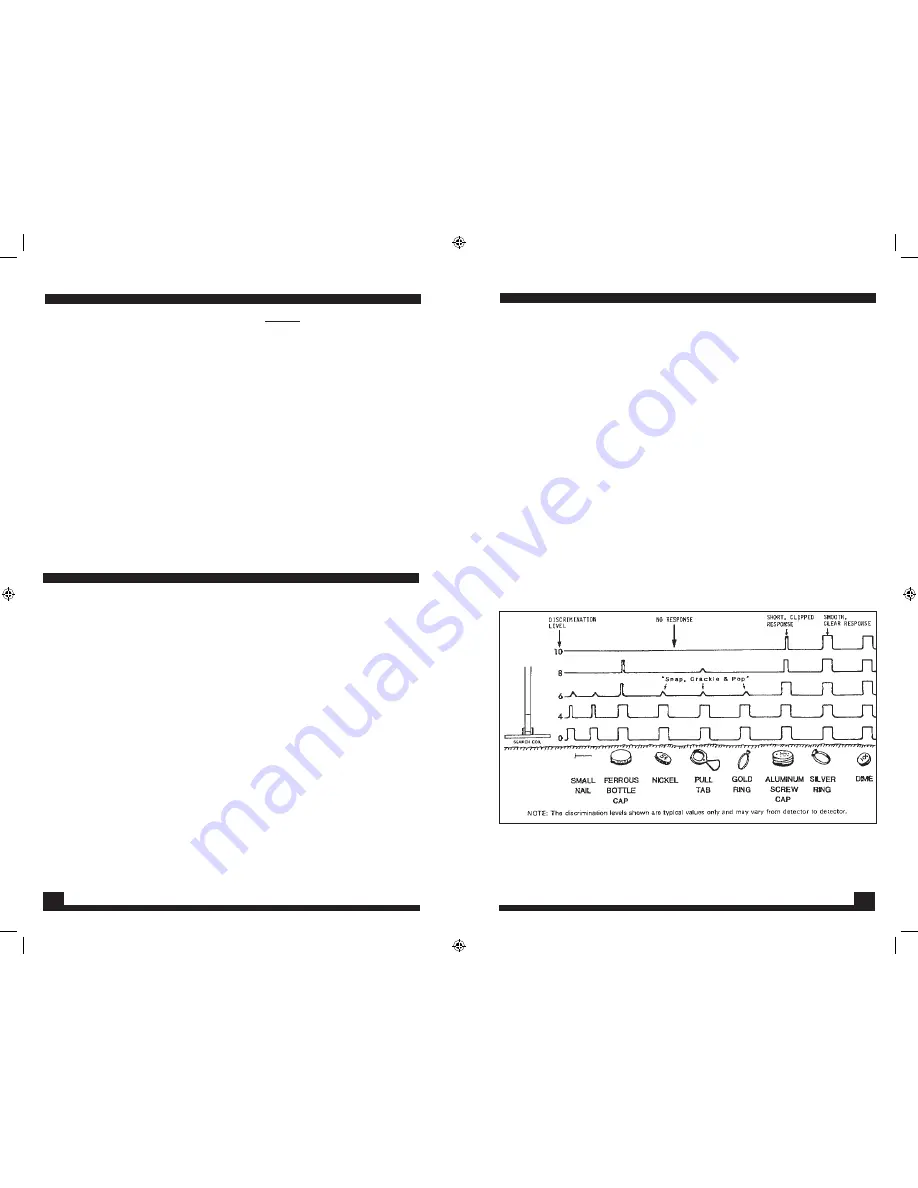
10
IRON DISC MODE
any metal. This may be tested quickly by
pulling the trigger switch and
sweeping over an area of about one square foot. If no signal is detected,
release the trigger switch and raise the search coil off the ground, and
lower it back down two or three times (also known as “bobbing”). If an
audible sound is heard, turn the GROUND ADJUST knob slightly clockwise.
Repeat this procedure until no sound is heard when raising and lowering
the coil to the ground. Once you have the 1270 adjusted to the type
of ground you are searching, you may begin sweeping the coil at a
comfortable pace. Remember, the ALL METAL GROUND ADJUST mode
is a MOTION mode. Slight movement of the coil is required to detect
an object. While in this mode, if the IRON DISC toggle is OFF, pushing
the MODE TRIGGER forward switches the 1270 into the NORMAL DISC
mode. If the IRON DISC toggle is ON, pushing the MODE TRIGGER forward
switches the 1270 into the IRON DISC mode. (SEE PRIMARY & SECOND-
ARY OPERATING MODES PG. 7)
Searching in IRON DISC may be preferred when small iron objects are
to be rejected. In fact, this mode greatly improves the detectors abil-
ity to “see through” iron trash to the good non-ferrous targets often
sought after. Make sure the ALL METAL GROUND ADJUST is OFF; that is,
fully counterclockwise until it “clicks” into the “0” position. Flip the IRON
toggle switch up into the ON position. Adjust your sensitivity clockwise
to the desired level (preferably until a slight threshold tone is heard, at
about “8” or greater). Reduce the sensitivity slightly if you prefer silent
search. In the IRON DISC mode, you have two features that enhance
the performance of the 1270: the SILENCER and the IRON DISC adjust
knob. The IRON DISC knob gives you the ability to “fine tune” the amount
of iron you wish to reject. Turning the IRON DISC knob clockwise causes
larger pieces of iron to be rejected. You may hear some normal “clicks
and pops” when the coil passes over these targets. In high trash areas,
turning the SILENCER toggle ON will reduce, and in most cases, eliminate
the “clicks and pops”. Remember that the IRON DISC mode is a MOTION
mode. Slight movement of the coil is required to detect an object. When
IRON DISC is the primary operating mode, pushing the MODE TRIGGER
forward switches the 1270 into the NORMAL DISC mode. (SEE PRIMARY
& SECONDARY OPERATING MODES PG. 7)
ALL METAL MODE
NORMAL DISC MODE
When rejection of a full range of other non-ferrous trash is desired,
the NORMAL DISC mode will be necessary. Make sure the ALL METAL
GROUND ADJUST is OFF; that is, fully counterclockwise until it “clicks” into
the “0” position. The IRON toggle switch must also be OFF. Adjust the
NORMAL DISC knob to reject the unwanted “trash” targets (see figure 2).
When the NORMAL DISC is set at “0”, all metals will be detected. As you
turn the NORMAL DISC knob clockwise, certain metals will be rejected.
At the full setting of “10”, most iron, foil, and aluminum will be rejected,
while copper and silver will still yield a good signal. Adjust your sensitiv-
ity clockwise to the desired level (preferably until a slight threshold tone
is heard, at about “8” or greater). Reduce the sensitivity slightly if you
prefer silent search. In high trash areas, turning the SILENCER toggle ON
will reduce, and in most cases, eliminate the “clicks and pops” that result
from some rejected targets. Remember that the NORMAL DISC mode is
a MOTION mode. Slight movement of the coil is required to detect an
object. When NORMAL DISC is the primary operating mode, pushing
the MODE TRIGGER forward switches the 1270 into the IRON DISC mode.
(SEE PRIMARY & SECONDARY OPERATING MODES PG 7).
11
Typical 1270 audio responses (with silencer off) for 2-inch deep targets
with search coil sweeping 1 to 2 inches above ground.
Figure #2
1270manual-.indd 10
6/13/06 2:50:11 PM




























